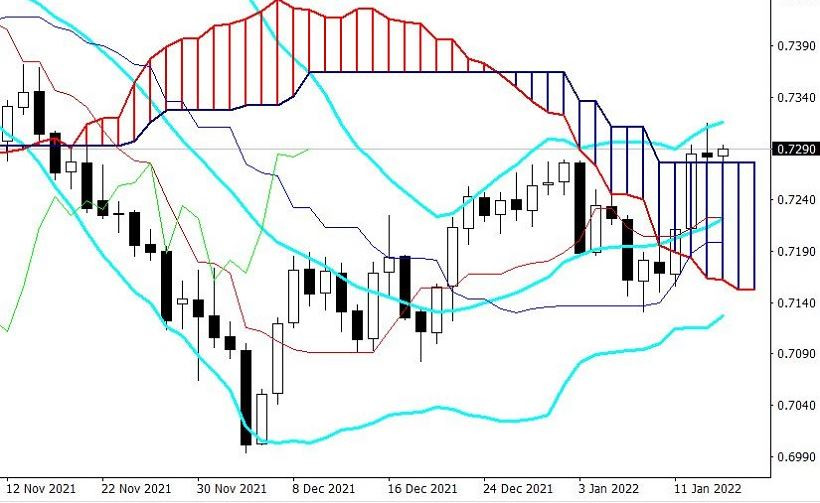
Buyers of the AUD/USD pair behave quite modestly and indecisively despite the US dollar's general weakening. It is worth noting that the US currency fell by more than 200 points in pairs with the franc and the pound, by almost 300 points in a pair with the Japanese yen, and by almost 400 with the Canadian dollar. In turn, the Australian currency rose by only a hundred points due to the devaluation of the US dollar, and the upward impulse actually stalled at the moment. Yesterday, AUD/USD buyers attacked the area of 0.73, but could only test the resistance level of 0.7310 (the upper line of the BB indicator on the daily chart), after which they retreated and fell to the 0.7280-0.7300 area.
All this suggests that the Australian dollar is not ready to take the lead. It is still trading in the wake of the US dollar, but nothing more. Contrary to the pound, the Australian dollar is not capable of doing things on its own terms. Therefore, the further fate of the upward correction depends solely on the US dollar's condition. As soon as it starts to be in demand again, the AUD/USD bears will strongly pull down the pair.

It is noteworthy that the Australian dollar actually ignored the controversial macroeconomic statistics that were published in the US yesterday. AUD/USD buyers did not benefit from the situation. Here, the number of initial applications for US unemployment benefits rose over the past week by 230,000. This is the worst result in the last 8 weeks. For the last two months, the indicator fluctuated in the range of 195-207 thousand, which is actually at the pre-crisis level. According to general forecasts, the indicator was supposed to reach 199 thousand this week. Therefore, it is not surprising that the 230,000 results disappointed the dollar bulls.
But another indicator, this time in the inflation field, showed a contradictory result. The general producer price index in monthly terms slowed down its growth, rising to 0.2% in December against the forecasted growth to 0.4%. The main reason for the decline in the growth rate of producer prices was the reduction in gasoline prices by 6.1% at once. In annual terms, the situation is somewhat better: the indicator increased to 9.7%, thus continuing the upward trend that has been developing for the 13th consecutive month since December 2020 (the indicator was at the level of 0.8% y/y). However, this component turned out to be in the red zone here too, as most experts expected to see it at the level of 9.9%. In turn, the core producer price index, excluding food and energy prices, showed a stronger result. It rose to 0.5% in monthly terms, which coincided with forecasts, and to the level of 8.3% in annual terms. The result is better than expected, a long-term record.
Traders of the AUD/USD pair remained indifferent to the above releases: after an uncertain attempt to reach the 0.73 region, they left the local high and fell into the drift of the flat movement.
Australian macroeconomic reports didn't help the AUD/USD buyers either. In particular, an Australian report on the volume of retail trade was released on Tuesday. The data was in the "green zone", exceeding the forecast level twice. It rose to 7.3% while expecting 3.5%, which is the best result since July 2020. At that time, the country was taking a break between lockdowns, which resulted in an increase in consumer activity. In November last year, Australia also significantly eased quarantine restrictions, which many residents of the Green Continent took advantage of.
But despite the favorable fundamental background, traders are not in a rush to open longs. If we look at the weekly chart, it can be seen that the pair actually compensated for last week's price decline during the current week. So, from January 3 to January 7, the Australian dollar dropped from the level of 0.7280 to a target of 0.7140. This week, the pair rose from 0.7144 to a high of 0.7315, after which it retreated to the area of 0.7280-0.7300. In other words, the pair only regained the positions lost last week, and then stopped at the border of the 73rd figure. It can be recalled here that the remaining major dollar pairs took advantage of the weakening of the US dollar differently, strengthening against it by 200-400 points.

All this suggests that longs on the AUD/USD pair are risky. It is currently recommended to take a wait-and-see attitude, given the so-called "Friday factor". However, if buyers of the Australian dollar do not consolidate in the area of 0.73 next week, then selling can be considered. The first (and so far the main) downward target is located at 0.7220 - this is the middle line of the Bollinger Bands indicator, which coincides with the Tenkan-sen line on the D1 timeframe.